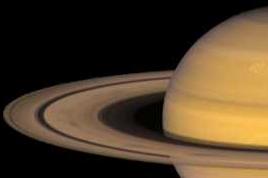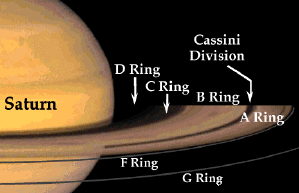Saturn and it's Famous Rings

 Like Jupiter, Saturn is about 75% hydrogen and 25% helium with traces of water,
methane, ammonia and "rock", similar to the composition of the primordial Solar
Nebula from which the solar system was formed.
Like Jupiter, Saturn is about 75% hydrogen and 25% helium with traces of water,
methane, ammonia and "rock", similar to the composition of the primordial Solar
Nebula from which the solar system was formed.
Saturn is visibly flattened (oblate) when viewed through a small telescope; its equatorial and polar diameters vary by almost 10% (120,536 km vs. 108,728 km). This is the result of its rapid rotation and fluid state. The other gas planets are also oblate, but not so much so. Saturn is the least dense of the planets; its specific gravity (0.7) is less than that of water. Saturn would float if you could find an ocean big enough for it.
Saturn's Interior and Atmosphere
Saturn's interior is similar to Jupiter's consisting of a rocky core, a liquid metallic
hydrogen layer and a molecular hydrogen layer. Traces of various ices are also
present. Saturn's interior is hot (12000 K at the core) and it radiates
more energy into space than it receives from the Sun. The energy is generated from
continued collapse (like in Jupiter) and perhaps radio-active decay.
Saturn has a very weak magnetic field.
 The bands so prominent on Jupiter are much fainter on Saturn
and much wider near the equator. Details in
the cloud tops are invisible from Earth. It was not until the Voyager encounters
that Saturn's atmospheric circulation could be studied. Saturn also exhibits
long-lived ovals and other features common on Jupiter (see small red
spot to left). In 1990, HST observed an enormous white cloud near Saturn's equator which
was not present during the Voyager encounters, suggesting these features come
and go on timescales of years or decades.
The bands so prominent on Jupiter are much fainter on Saturn
and much wider near the equator. Details in
the cloud tops are invisible from Earth. It was not until the Voyager encounters
that Saturn's atmospheric circulation could be studied. Saturn also exhibits
long-lived ovals and other features common on Jupiter (see small red
spot to left). In 1990, HST observed an enormous white cloud near Saturn's equator which
was not present during the Voyager encounters, suggesting these features come
and go on timescales of years or decades.
 Those Fantastic Rings of Saturn
Those Fantastic Rings of Saturn
Two prominent rings (A and B) and one faint ring (C) can be seen from the Earth.
The gap between the A and B rings is known as the Cassini division.
The Voyager pictures show four additional faint rings. Saturn's
rings, unlike the rings of the other planets, are highly reflective and
bright.
Though they look continuous from the Earth, the rings are actually composed of innumerable small particles each in an independent orbit. They range in size from a centimeter or so to several meters. A few kilometer-sized objects are also likely. Saturn's rings are extraordinarily thin: though they're 250,000 km or more in diameter they're less than one kilometer thick. Despite their impressive appearance, there's really very little material in the rings -- if the rings were compressed into a single body it would be no more than 100 km across. The ring particles seem to be composed primarily of water ice, but they may also include rocky particles with icy coatings.